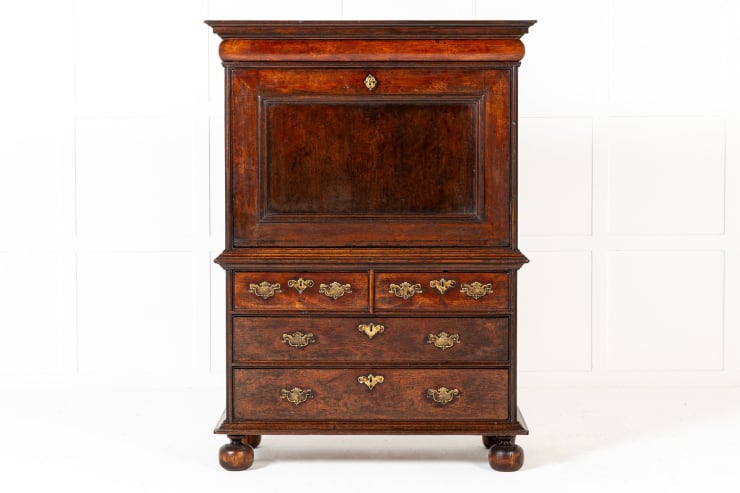-
Antiques from the 17th Century from Consoles to Chairs, and Mirrors to Chests.
The 17th century saw significant developments in the world of antiques. This period, also known as the Baroque era, was characterized by lavishness and opulence in art and design. Antiques from this period are highly valued and sought after by collectors and connoisseurs worldwide.
Looking for something a little later? Why not browse our 18th Century Collection or 19th Century Collection
-
Our curated collection of 17th Century Antiques
-
Here is a little more about Antiques from the 17th Century...
History, Evolution & TechniqueDuring the 17th century, many countries in Europe experienced economic and cultural growth, which led to the production of high-quality antiques. The French, for instance, became famous for their furniture and decorative art, while the Dutch excelled in the production of Delftware and silverware. The English, on the other hand, produced some of the finest and most expensive ceramics in the world.
One of the most significant developments of the 17th century was the introduction of new techniques and materials. The use of ebony, ivory, and tortoiseshell became prevalent in the production of furniture, and the art of marquetry, which involves the inlaying of different materials to create intricate patterns and designs, reached new heights.
The 17th century also saw the rise of the art market, with wealthy collectors commissioning artists and craftsmen to produce unique and highly decorative pieces. Many of these pieces were highly symbolic, with intricate designs that conveyed messages or told stories.
As with all periods in history, the 17th century saw its fair share of social and political upheaval, which had a significant impact on the production and availability of antiques. Wars, revolutions, and economic crises often resulted in the destruction or loss of valuable items, while new opportunities for trade and exploration led to the discovery of previously unknown pieces.
Today, 17th century antiques remain highly prized, and collectors are willing to pay significant sums of money for these items. Whether it's a piece of furniture, a work of art, or a piece of decorative pottery, these antiques offer a glimpse into the opulence and extravagance of the Baroque era.
-
The most popular types of antiques in the 17th Century...
There are several types of antiques that were popular during the 17th century, many of which remain highly coveted by collectors and connoisseurs today. Here are some of the most popular antiques from this era:
-
Antique Furniture: Furniture from the 17th century was often ornate and highly decorative, with intricate carvings and inlays. Common styles included Baroque, Rococo, and William and Mary. Popular pieces included tables, chairs, cabinets, and beds.
-
Antique Ceramics: The 17th century saw the production of some of the finest ceramics in history, particularly in England, where the art of pottery flourished. Pieces were often decorated with intricate patterns and designs, and included types such as delftware, faience, and porcelain.
-
Antique Silverware: Silverware was highly valued during the 17th century, and wealthy families often commissioned craftsmen to create bespoke pieces. Popular items included candlesticks, bowls, and cutlery.
-
Antique Paintings: The 17th century was a golden age of painting, with artists such as Rembrandt, Vermeer, and Caravaggio producing some of their most famous works during this period. Portraiture was particularly popular, as were religious and historical scenes.
-
Antique Scientific instruments: The 17th century saw significant advancements in science and technology, and many of the instruments used during this time were finely crafted and highly decorative. Items such as globes, astrolabes, and telescopes were in high demand.
Overall, antiques from the 17th century represent a unique and fascinating period in history, and remain highly sought after by collectors and enthusiasts worldwide.
-
-
Restoration Techniques from the 17th Century...
In the 17th century, restoration techniques for antiques were much more rudimentary than those used in later centuries. Here are some of the most common techniques used at that time:
-
Joinery: Joinery was the primary technique used to repair furniture in the 17th century. This involved cutting new pieces of wood to replace damaged or missing parts of the furniture, and then carefully fitting them into place using dovetail joints or other techniques.
-
Glue: Glue was used to repair cracks and splits in wooden furniture. Animal-based glues, such as hide glue or fish glue, were most commonly used, as they could be easily softened with heat and repositioned if necessary.
-
Nail and Screw Replacement: When nails or screws became loose or were lost, they were replaced with new ones. Nails were typically made of iron and screws were often made of brass or copper.
-
Wax: Wax was used to fill small holes and cracks in wooden furniture. It was melted and poured into the affected area, then smoothed over and allowed to harden.
-
Color Touch-up: Color touch-up was used to restore the color and finish of furniture that had become faded or damaged. Pigments were mixed with oils or other binders to create a paste that was then applied to the surface of the furniture.
Overall, the restoration techniques of the 17th century were basic and focused mainly on functional repairs rather than cosmetic restoration. Many of these techniques are still used today in conjunction with more advanced methods to restore antique furniture to its original condition.
-
-
Our Top Tip Insights
-

Top 5 Tips on - Buying Antiques for a Room
5 simple tips to help you style, buy and create your perfect room July 9, 2023 -

3 Steps To Build Working Relationships With Interior Designers
May 1, 2023 -

Timeless Treasures: Top 5 Tips for Antique Furniture Restoration
Preserving History and Beauty for Generations to Come August 13, 2023 -

Preserving the Past: 5 Essential Tips for Antique Furniture Enthusiasts
Unraveling the Secrets of Antique Furniture Tips for Enthusiastic Collectors August 13, 2023
-












